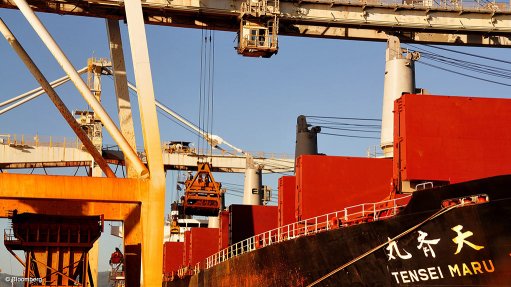
Photo by: Bloombeg
PERTH (miningweekly.com) – Australia’s iron-ore exports to China increased by 6% year-on-year to 155-million tonnes in the quarter ended June 30, the Office of the Chief Economist reported on Thursday.
Although China’s iron-ore imports had decreased by 4% year-on-year to 226-million tonnes in the quarter, Australia’s share of these imports continued to increase, growing from 59% in the second quarter of 2014 to 65% in the quarter under review.
In the latest edition of the China Resource Quarterly (CRQ), it was noted that despite the increase in export volumes, Australia’s iron-ore export earnings declined by 30% year-on-year to A$9.4-billion following a 43% fall in the price of iron-ore.
The CRQ pointed out that most commodity prices continued to decline in the second quarter, driven largely by an ongoing increase in supply. While China’s demand for most imported raw materials had been reasonable in volume, Australia’s overall export earnings from trade with China had declined owing to sharp falls in the price of most metals and energy products.
Australia exported some 10.8-million tonnes of metallurgical coal to China during the second quarter, down 7% on the previous corresponding period. The value of the exports, however, increased by 7% to A$1.3-billion, partly reflecting currency depression.
Thermal coal exports also declined by 23% on the previous corresponding period, to ten-million tonnes, with the value of thermal coal exports declining by 27% to A$635-million.
Meanwhile, the value of Australia’s nickel exports to China reached A$923-million during the quarter, while gold contributed A$1.98-billion in export earnings and copper a further A$944-million.
Liquefied natural gas (LNG) imports from Australia increased by 42% on the previous corresponding period, to 1.3-million tonnes, with the value of LNG imports increasing by 171%, to $433-million.
The Queensland Curtis LNG project began operating in the second quarter of 2015 and was expected to provide China with up to 3.6-million tonnes a year of LNG for the next 20 years, with the China National Offshore Oil Corporation acting as the second-largest investor in the project.
Looking at activities within the Chinese border, the CRQ noted that growth in heavy industry and mining investment in China was lacklustre in the second quarter.
The proportion of industrial firms making a loss increased in the second quarter, and coal mining and ferrous metals smelting investment was weak. However, investment in infrastructure remains a bright spot in China’s economy as investment in transport infrastructure continues to display strong growth.
China’s steel production declined 1% in the second quarter, compared with the previous corresponding period, to 208-million tonnes.